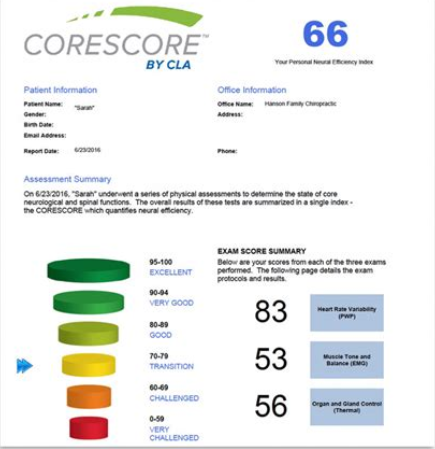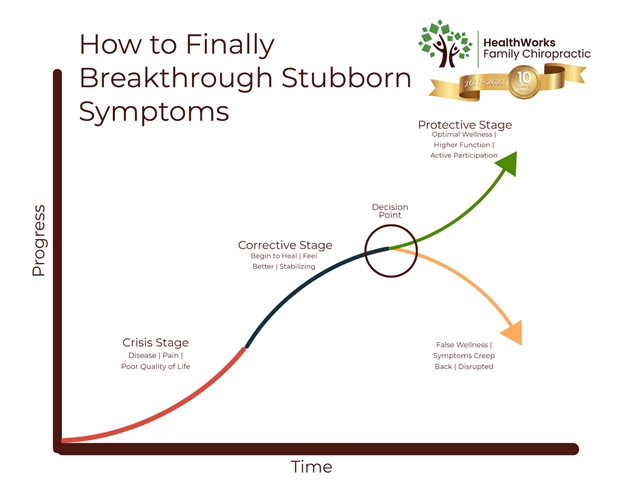How far will you take your chiropractic care?
The choice is completely up to you. Each chiropractor at HealthWorks Family Chiropractic and our team members are here in any capacity based on your goals, lifestyle, and wishes. Our job is to give you our best recommendations, your job is to tell us how much you want.
We completely understand that the very reason you set foot in HealthWorks is to get rid of pain, so that’s ultimately our initial goal. But, did you know that unless you treat the underlying issue, your pain will continually come back, and you will never get rid of the pain? Who wants to be on a roller coaster ride (see image below) like that for the rest of their lives?? Not me!
Unfortunately, pain or lack of pain is not the greatest indicator of whether your problem has been corrected—the pain is usually the very first thing to go! Thank goodness! However, it typically provides a false sense that the problem is gone, when correcting the cause is simply just in its infancy.
When joints are out of alignment and have been moving improperly for years, this creates inflammation. Inflammation causes pain. Specific and gentle adjustments, performed by your chiropractor, restore proper motion and movement to the joints over time and reduce the inflammation—pain starts to diminish. However, this is when the real work begins! Once the joints start moving properly, the proper structure of the spine—the true cause of most spinal/back/neck issues, can finally be addressed. So, the very worst time to stop chiropractic care is when you are finally out of pain!
Each adjustment builds on the next one which creates a stronger structure and better biomechanics every time. You can’t expect to go to the gym, do a couple of bicep curls and expect to be sporting some guns the next day! Consistent chiropractic care TRAINS your spine to stay in proper alignment!
Understanding each stage of care
When it comes to your personalized care, understanding each stage as you heal, will help you to make the very best decisions every step of the way.

Stages for chiropractic care
Crisis Stage
When many people seek care at HealthWorks Family Chiropractic, they have one goal: pain relief. So that’s where we most often start. During this initial stage of care, chronic disease and pain and a poor quality of life are what define this stage of care and typically drive people to seek care.
- Uncovering the underlying cause of your problem is the initial goal.
- Recommend a care plan to produce the most efficient results possible
- Offer ways you can actively participate in your improvement and recovery
How do we uncover your root cause?
X-Ray Imaging
X-rays are one of the most questioned by patients. We’ve been scared all our lives into thinking that X-rays are harmful, and we should avoid them at all costs. Although I can understand this line of thinking, the science does not support that general spinal films, applied using a digital system, along with the lead filters we utilize, the radiation is reduced from 65-97% depending on the area imaged. Read more here.
The CoreScore
The CoreScore evaluates the function of the nervous system. The spine and spinal nerves reside in the spinal column and therefore the evaluation of this function is crucial in finding out what nerves are irritated and what nerves are functioning well. This allows us to determine the cause of the problem and not simply chase your symptoms around.
Here’s an example of a CoreScore report:

Corescore report
What do the numbers mean?
Think of these numbers like grades; the higher the better, with 100 being the perfect score. We use these scans not only to find out where you are when you first come in, but how you are progressing during your course of care.
What is Heart Rate Variability (HRV)?
This scan shows us how well your body is able to adapt to external stressors-chemical, physical and emotional. In other words, how much ability you have to heal and change, and what kind of initial outcome we can expect.
What is a Surface EMG scan (sEMG)?
This scan called a Surface Electromyograph, reveals surface electricity and the variations from one level to the next. Subluxations cause changes in muscle tone that show up on this scan as changes in surface electricity. It determines how well the nerves to your muscles are functioning.
What is a Thermal Scan?
This scan measures heat along your spine. When misalignments are present, there can be a change in temperature from one side to the other (asymmetry), due to changes in blood supply. This helps us determine what nerves, that supply information to your organs and glands, may be inflamed and irritated.
Overall, the CoreScore helps us determine the overall health of your nervous system. The nervous system is very elusive and where you feel the problem, may not be the cause. This, along with correlating your other diagnostics give us a great roadmap to determine the very best course of care for your individual case.
Posture/Palpation and Leg Check
I’ve gone extensively over how posture is so important when it comes to spinal health and well-being in previous blogs, so check those out too! Essentially, posture is the “window to the spine”. It allows us to see what muscle groups are functioning properly and which ones may be compensating depending on how you present.
How do we determine the best care plan for your healing?
To answer that question, we must discuss the factors that determine healing time.
- Age—the older you are the more time your body has had to degenerate, and more so, the more time it has had to have damage from auto accidents, slips and falls, sports injuries, and of course, stress!
- Fitness level—from couch potatoes to Cross Fit aficionados, we see them all. These and everyone in between have their own challenges to healing, and each are very unique.
- How long you’ve been in pain—pain is typically the last sign that something is wrong when it comes to degenerative conditions of the spine. I can’t tell you how many people walk into our office and report doing something completely innocuous like picking up a pencil and all of a sudden not being able to get back up again. Did that injury happen just then or did the condition that set the stage for this “proverbial straw” occur years or possibly decades earlier?
- The type of injury or chronic condition(s) you have—has it been a long-term and/or intermittent issue you’ve had, or did you just get hit by a baseball bat in the back of the head at your company co-ed game? What tissues were affected? Do you have comorbidities that cause underlying inflammation that would make healing more difficult and more time-consuming? These are questions that play into how well and effectively you can heal.
- Lifestyle factors—how much water do you drink? Do you exercise? Are you a fast food junky? Are you on multiple medications that have side effects contributing to your pain/condition? The way you treat your body daily will undoubtedly play into how fast or well you heal.
The main factors that determine your healing time can be in the multiples as you can see. Of course, we live in a microwave society and are used to things being done in 30-seconds or less. Unfortunately, this is not the way the human body heals. The fact is, it’s not that simple.
After these questions are answered via both subjective and objective findings (your symptoms, history, and diagnostics), we will present our best recommendations. Precision chiropractic care is our foundation; however, we do offer options that can enhance your recovery with nutritional support, therapies, home exercises, and detoxification modalities. Many of our recommendations are designed to actively participate in your healing at home or even at your workplace.
Corrective Stage
Corrective care is the stage when you are not feeling many symptoms, but not in the stage of protective or wellness. You may feel symptoms from time to time but staying on a regular care plan with regular adjustments, along with the recommended exercises and better nutrition can catapult your health into the protective stage. The time frame within this phase can take more dedication to your care due to the fact we are no longer relying on the presence or lack of symptoms, rather moving toward the protective stage and tracking progress through regular posture scans and CoreScore evaluations.

Progress stage disrupted
What happens when you discontinue care?
When in the corrective stage, better motion and movement have been achieved and inflammation is finally subsiding. When you choose this as a stopping point, it’s inevitable that your symptoms will start to creep back and all the care that you had previously will be disrupted. The good news, however, is that what you have lost, can be quickly recovered once back under care again and you can get right back on track! It’s important to get started back right away or at least come back periodically should you need to discontinue care for time or financial reasons, as the longer you are out of alignment, the longer it will take to return to stabilization (see image above).
Protective Stage
Believe it or not, a handful of patients do come in and clinically qualify to start in our Lifetime Family Wellness program, which is those in the protective stage. This care plan helps to maintain optimal wellness and structural integrity for the nervous system to function at its very best.
This is the ultimate goal in your course of care and in this stage, stabilization has occurred, and maintaining all the health you have achieved becomes a reality. Isn’t that what you want from any healthcare you choose?
Our promise to you
HealthWorks Family Chiropractic is dedicated to a comprehensive and specific approach to taking care of spinal and nervous system needs. Let us help you find out how taking care of the most important system in the body will create optimal health that will last a lifetime!
If we find we’re not the best to help, we promise to refer you to someone who is.
We hope you think of us when you search for “Chiropractor near me”, we want to be YOUR chiropractic healthcare home!
